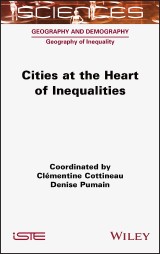Details

Cities at the Heart of Inequalities
1. Aufl.
|
126,99 € |
|
| Verlag: | Wiley |
| Format: | |
| Veröffentl.: | 15.06.2022 |
| ISBN/EAN: | 9781119986799 |
| Sprache: | englisch |
| Anzahl Seiten: | 256 |
DRM-geschütztes eBook, Sie benötigen z.B. Adobe Digital Editions und eine Adobe ID zum Lesen.
Beschreibungen
Cities have become the major habitat for human societies. They are also the places where the starkest social inequalities show up. Income, social, land and housing inequalities shape the built environment and living conditions of different neighborhoods of cities, and in return, unequal access to services, environmental quality and favorable health conditions in different neighborhoods and cities fuel the reproduction of interpersonal inequalities.<br /><br />This book examines how inequalities are produced and reproduced both within and between cities. In particular, we review land rent and social segregation theories from diverse disciplinary references and through examples taken from around the world. The attraction of urban centralities, which is further reinforced by the growing financialization of property and urban capital, is also analyzed through the lens of its influence on rent-seeking mechanisms and the ever increasing pressure of population migration.
<p>Preface ix<br /><i>Denise PUMAIN and Clémentine COTTINEAU</i></p> <p><b>Chapter 1. Major Models of the Spatial Organization of Urban Societies 1</b><br /><i>Clémentine COTTINEAU and Denise PUMAIN</i></p> <p>1.1. Historical evolution of the spatiality of social status markers in the city 2</p> <p>1.2. Slums, informal settlements and shanty towns 12</p> <p>1.3. Institutional segregation 16</p> <p>1.4. Separations by choice 21</p> <p>1.5. Mobility and unequal accessibility in urban space 26</p> <p>1.6. Corrections and remedies 30</p> <p>1.7. Conclusion 35</p> <p>1.8. References 35</p> <p><b>Chapter 2. Land Rent and the Center--Periphery model 45</b><br /><i>Denise PUMAIN</i></p> <p>2.1. Introduction 45</p> <p>2.2. Space and rent: the urban field 47</p> <p>2.3. Variations of the urban field by city 58</p> <p>2.4. Towards a complex explanatory construction of urban rent inequalities 64</p> <p>2.5. Financialization of urban development and conflicts over land use? 67</p> <p>2.6. Conclusion 72</p> <p>2.7. References 72</p> <p><b>Chapter 3. Inequalities in Access to Urban Services 79</b><br /><i>Eugenia Doria VIANA CERQUEIRA</i></p> <p>3.1. Introduction 79</p> <p>3.2. Urban services: definitions 81</p> <p>3.3. Urban services and issues of socio-spatial inequality 82</p> <p>3.4. Access to urban services: a plurality of dimensions 90</p> <p>3.5. Conclusion 96</p> <p>3.6. References 97</p> <p><b>Chapter 4. Gentrification and the Real Estate Market: What Can We Learn from the Rent Gap Theory? 105</b><br /><i>Guilhem BOULAY</i></p> <p>4.1. Introduction 105</p> <p>4.2. The theoretical basis for thinking about gentrification 108</p> <p>4.3. Apparent simplicity leads to great success 112</p> <p>4.4. Testing and quantifying the rent gap hypothesis 118</p> <p>4.5. What place for the rent gap theory in the geography of real estate? 125</p> <p>4.6. Conclusion 129</p> <p>4.7. Acknowledgments 130</p> <p>4.8. References 130</p> <p><b>Chapter 5. Socio-spatial Segregation in Cities 137</b><br /><i>Renaud LE GOIX</i></p> <p>5.1. Segregation in metropolises, renewed theoretical issues 137</p> <p>5.2. Segregation, social division of space and restratification in the contemporary city 139</p> <p>5.3. From observations to theories: the multiple factors of segregation 147</p> <p>5.4. Analyzing segregation, scales and temporalities 154</p> <p>5.5. Conclusion 160</p> <p>5.6. Acknowledgments 161</p> <p>5.7. References 161</p> <p><b>Chapter 6. Migrants In and Between the Cities of the World 173</b><br /><i>Armelle CHOPLIN, Hasnia-Sonia MISSAOUI and Olivier PLIEZ</i></p> <p>6.1. Introduction: migration, urbanization and inequalities 173</p> <p>6.2. City networks and migration networks: a coincidence rather than a given 176</p> <p>6.3. Migration flows creating urban systems 183</p> <p>6.4. Conclusion. Migrants and cities: creators and accelerators of inequalities? 194</p> <p>6.5. References 195</p> <p><b>Chapter 7. Inequalities Between Cities 205</b><br /><i>Clémentine COTTINEAU</i></p> <p>7.1. Interweaving of scales and cities 205</p> <p>7.2. Inequalities related to urban functions 208</p> <p>7.3. Inequalities related to urban status and city powers 213</p> <p>7.4. Size inequalities 217</p> <p>7.5. Image inequalities 221</p> <p>7.6. Conclusion 226</p> <p>7.7. References 226</p> <p>Conclusion 233<br /><i>Denise PUMAIN and Clémentine COTTINEAU</i></p> <p>List of Authors 237</p> <p>Index 239</p>
<p><b>Clementine Cottineau</b> is Assistant Professor of Urban Studies at Delft University of Technology, The Netherlands, and Chargée de recherche at CNRS, France. Her research focuses on models of urbanization and urban inequality.</p> <p><b>Denise Pumain</b> is Emeritus Professor of Geography at the University of Paris 1 Panthéon-Sorbonne, France. Her research focuses on theories and models of urban systems.</p>

















